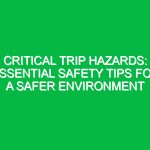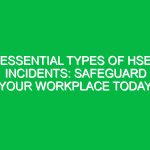Introduction
Hello team! Thank you all for gathering for today’s toolbox talk. Today, we’re diving into an essential topic that affects every aspect of our daily operations: What Kind of Influence Are You? Understanding our influence in the workplace is crucial for fostering a safe and productive Environment. Each of us plays a vital role in health, safety, and environment (HSE) practices, and how we interact with each other can significantly impact our Safety culture.
The Importance of Influence in HSE
Influence is defined as the capacity to have an effect on the character, development, or behavior of someone or something. In the context of HSE, it’s about understanding how our actions and attitudes can inspire, motivate, and even deter our colleagues from making safe choices.
Let’s consider the following points to illustrate this:
- Positive Influence: When you demonstrate Safe Practices consistently, others are likely to follow. Think of a colleague who always wears their Personal Protective Equipment (PPE) correctly. Their behavior sets a standard and encourages the whole team to prioritize Safety.
- Negative Influence: Conversely, if someone frequently disregards safety protocols, it can lead to a culture where unsafe practices are tolerated. This behavior can endanger not just the individual but also their coworkers.
Recognizing the kind of influence we have is the first step in shaping a safer workplace.
Types of Influence
Let’s break down the types of influence we can exhibit in our work environment:
1. Direct Influence
Direct influence occurs through active engagement. This is when you lead by example, provide guidance, or directly communicate safety Procedures to your colleagues. For instance, if you notice a coworker forgetting to wear their hard hat, addressing it directly can prevent potential accidents.
2. Indirect Influence
Indirect influence is subtler. It can happen through the attitudes and behaviors we display. If you remain calm and collected in stressful situations, your colleagues are more likely to mirror that composure during emergencies.
3. Peer Influence
Peer influence is significant in a workplace setting. It involves the informal power you have among your colleagues. When you encourage your peers to speak up about Hazards or unsafe practices, you create an environment where safety is prioritized.
Assessing Your Influence
Now that we understand the types of influence, let’s assess our current impact. Ask yourself:
- Do I prioritize safety in my actions and communications?
- How do my colleagues respond to my safety practices?
- Am I aware of how my behavior can affect others?
Taking a moment for self-reflection can help you identify areas for improvement and fortify your positive influence.
Real-Life Scenarios
Let’s look at a couple of scenarios that might resonate with you:
Scenario 1: The Safety Champion
Imagine Sarah, a team member who consistently reminds her colleagues to check their equipment before use. Her proactive approach not only ensures everyone is using the right tools but also fosters a culture of safety. Sarah’s influence encourages her coworkers to adopt these practices as part of their routine.
Scenario 2: The Bystander Effect
Now consider Mike, who notices a colleague working without gloves. Instead of speaking up, he decides to stay silent, thinking someone else will intervene. This bystander effect can lead to accidents and reinforces unsafe behaviors. Mike’s decision impacts not only the individual but the entire team’s safety culture.
These scenarios highlight how our responses to situations can shape our workplace environment. We must strive to be the positive influence that encourages Safe Practices.
Best Practices for Positive Influence
To ensure we are all contributing positively to our HSE culture, here are some Best Practices:
- Communicate Openly: Share your thoughts on safety procedures and encourage others to do the same. Open dialogue can lead to improvements and a stronger safety culture.
- Be Approachable: Create an environment where colleagues feel comfortable discussing safety concerns. Your willingness to listen can encourage others to speak up.
- Lead by Example: Be the person who follows safety protocols without fail. Your actions set a standard for others.
- Encourage Team Participation: Involve your colleagues in safety conversations and decision-making processes. When everyone contributes, it strengthens the commitment to safety.
Potential Hazards and Risks
Understanding What Kind of Influence Are You? also means recognizing potential hazards connected to our behavior. Here are a few risks associated with negative influence:
- Complacency: If safety procedures are taken lightly, complacency can set in, leading to a higher likelihood of accidents.
- Peer Pressure: Negative peer pressure can push individuals to disregard safety protocols. It’s essential to counter this by fostering a culture that values safety above all.
- Ignoring Feedback: When team members feel their concerns are dismissed, they may stop reporting hazards, increasing risk.
Identifying these risks is crucial to countering negative influences and promoting a safer workplace.
Regulations and Standards
Compliance with health and safety Regulations is not just a legal obligation; it’s a moral one. Familiarize yourself with the relevant regulations that affect our industry. Here are a few key points:
- The Occupational Safety and Health Administration (OSHA) provides guidelines that emphasize the importance of safety protocols.
- Adherence to local and national safety standards is vital for maintaining a safe work environment.
- Company policies should reflect these regulations and encourage a proactive safety culture.
Understanding and complying with these standards not only protects you but also your colleagues and our organization.
Conclusion
As we wrap up today’s toolbox talk, remember that your influence—both positive and negative—plays a pivotal role in our safety culture. Ask yourself What Kind of Influence Are You? and consider how you can contribute to a safer workplace. By leading through example, maintaining open communication, and encouraging participation, you can be a force for positive change.
Thank you all for your attention and for your commitment to making our workplace safer. Let’s continue to look out for one another and uphold the highest safety standards.


